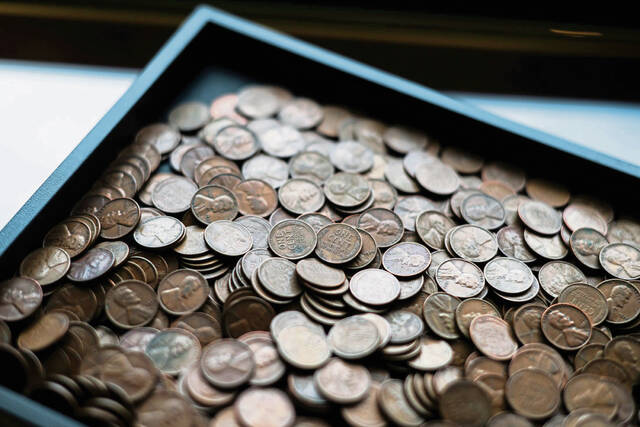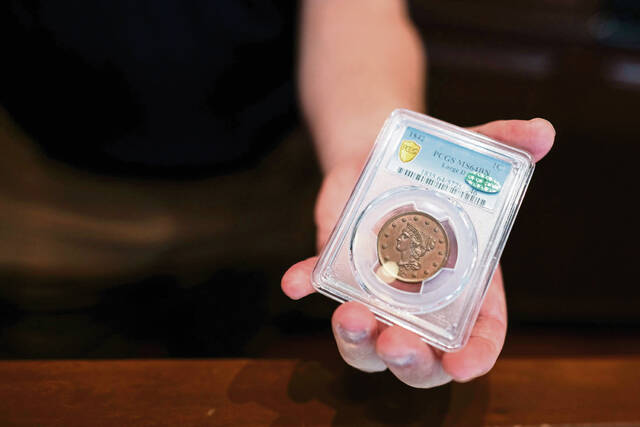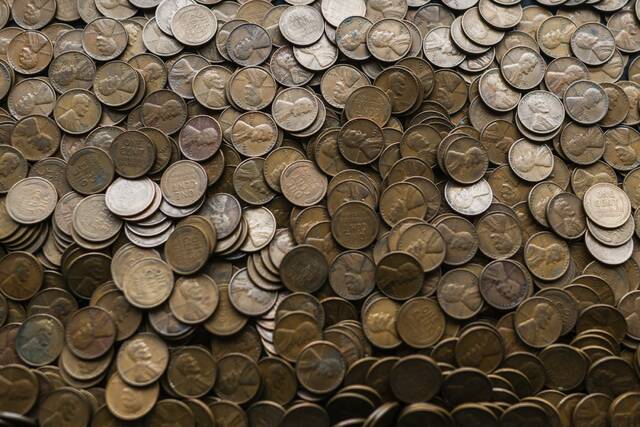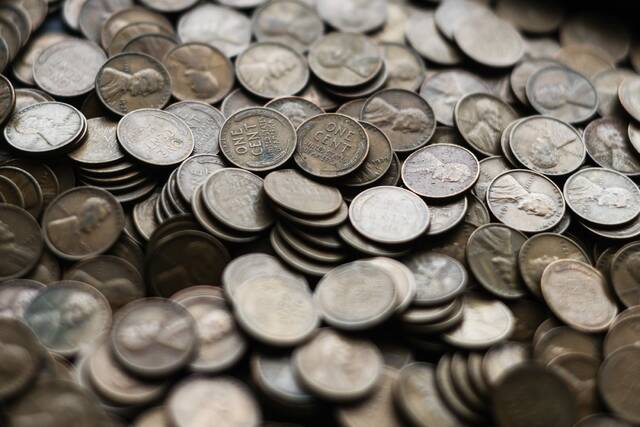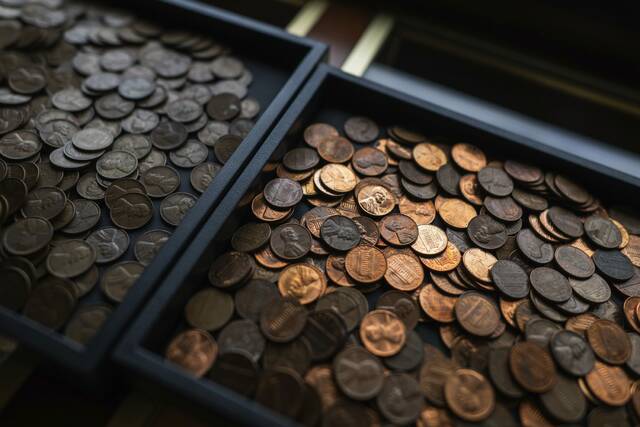A nationwide penny shortage leaves businesses in the dark without government guidelines
The penny is having its 15 minutes of fame, even as time runs out for the ubiquitous coin.
President Donald Trump in February directed the U.S. Treasury to stop producing new pennies, which cost more than 3 cents to produce. Since then, U.S. mints have stopped production. They delivered their last shipment of new pennies in August.
But Congress and the Treasury haven’t issued any guidelines for banks and other businesses on how to handle the eventual demise of the penny.
The situation has some companies scrambling to get pennies so they can continue to give customers exact change until the government issues guidelines.
Consumers are in a sort of limbo, with some companies continuing business as usual while others announce rounding prices to the nearest nickel for those paying with cash.
“It’s sad,” said Adam Starkey, vice president of Olevian Numismatic Rarities, a rare coin, paper money and precious metals supplier based in Pittsburgh’s Shadyside neighborhood. He said, since the penny was discontinued, people have been making runs to hoard 2025 pennies. “It’s the end of an era. The penny is a benchmark of American currency that’s been going strong since 1909.”
Pennies won’t suddenly disappear. According to an October release from the American Bankers Association, an estimated 250 billion pennies are still in circulation.
Companies with questions
While pennies may not be worth a lot in terms of dollars and cents, retailers, banks and other businesses are scrambling to cope after receiving no guidelines from the government for the discontinuation of the penny.
Allegheny Health Network hospital cafeterias are practicing “neutral rounding” on cash transactions, meaning prices are rounded to the nearest nickel.
“Due to the penny shortage and forthcoming discontinuation, AHN has adjusted cafeteria prices for cash transactions,” said a statement from AHN. “Prices for digital or debit card transactions remain the same.”
According to various reports from across the state, some Sheetz locations have posted signs saying they’re short on change.
The stores encouraged customers to use credit or debit cards, or a phone payment app. The signs also encourage customers to “round up” cash purchases to support charity, or to “cash in one dollar’s worth of spare pennies to receive a self-serve drink.”
Sheetz did not respond to a request for comment.
To avoid being hit by the penny shortage, Giant Eagle invited people to trade their loose pennies on Nov. 1 for a store gift card worth double the value of their contribution.
“Our immediate focus is maintaining a sufficient level of pennies across stores for as long as possible,” said Giant Eagle spokesperson Dan Donovan.
Saturday’s event, he said, was the company’s latest effort to maintain coin supplies at the grocery giant. He said store locations share pennies among themselves, and the company has been working with its third-party exchange partners such as Coinstar to provide some locations with penny inventory.
“There’s a reality that there’s a future where pennies are not in circulation,” Donovan said. “Retailers in general are looking forward to guidelines from the government to give some recommendations on how retailers would give change in a world without pennies.”
He called the issue complex. Simply changing the prices of all products to avoid pennies, and the changes that would lead to when sales tax is calculated, could result in an unknown amount of costs to companies and consumers.
Donovan said the penny event hopefully will give the stores enough pennies to last until there are sufficient guidelines released from the government.
“We have a ‘to be determined’ period of time where we want to make sure we can show up for our customers that can pay with cash and give them their exact change,” Donovan said. “We want to maintain an adequate amount of pennies for as long as we can. We don’t know how long that will be.”
He said the company is exploring all options if the stores run out of pennies before any guidelines are released.
Economic effect
Giant Eagle isn’t the only business concerned about the lack of regulation.
At the end of September, a group of major retailers sent a letter to Congress asking for guidelines.
The letter asked for legislation that will create a national law allowing businesses to round transactions to the nearest nickel, ensure rounding for cash customers does not violate terms of the Supplemental Nutrition Assistance Program (SNAP) and facilitate check cashing at retail locations. As of now, nonuniform rounding methods run the risk of violating consumer laws in certain states.
In addition, the American Bankers Association wrote a letter to Federal Reserve and the Treasury.
Steve Kenneally, senior vice president of payments at the American Bankers Association, said pennies have become elusive much faster than the association expected.
One reason for this is the Federal Reserve shutting down penny transactions at coin terminals across the country, making it difficult for banks that are low on the coin to get pennies and for banks flush with them to spread the supply out evenly.
“As of now, the Federal Reserve has shut down penny transactions in 85 locations out of around 165 locations,” Kenneally said.
This means, when retailers put orders in for change, banks often are unable to supply pennies, which causes problems in giving exact change to customers. While the transaction closures have been going on since the last production in August, everyday consumers are starting to feel the effect.
“It has posed a challenge for banks and retailers that rely on cash,” Kenneally said. “We are asking for the government to come out with a transition plan. It would help to have a plan to manage (the penny) out of existence. I think the short-term solution would be to reopen those coin terminals.”
Kenneally said the association hasn’t received any response to its letter.
“I think it’s too soon to say we’re on our own,” Kenneally said. “It takes time to hear back. … We want to work with the federal government to find a solution that will work for everybody.”
Chester Spatt, a professor of finance at the Tepper School at Carnegie Mellon University, said it’s a positive to say goodbye to the penny.
“These days, people don’t carry around a lot of pennies,” Spatt said. “People are using less and less currency and less and less coins.”
He said, since society has gradually moved away from needing and using pennies often, their absence is not a significant loss.
“I think that my view is, if the resource costs are substantially more than the product, it’s not compelling to keep them,” Spatt said.
When asked about the struggles retailers have with making exact change, Spatt said it’s merely a matter of adapting.
“(Businesses) have had to adapt in the past with the debit card,” Spatt said. “Firms will need to adapt. … I think this issue has been out there. It’s not like it was decided last week. I think it’s a good development.”
While he doesn’t believe the lack of pennies will feed inflation, it will partially depend on where companies end up placing their prices to get the penny out of the equation.
“I just don’t see this as a significant loss,” Spatt said. “(The penny) is a waste of societal resources.”
End of an era
The United States began minting pennies in 1793, the year after Congress authorized the creation of a national mint. President Abraham Lincoln was the first president to be featured on a coin, starting in 1909, the centennial of his birth.
“Economically, we know it makes sense,” said Starkey, the Shadyside coin expert.
According to the U.S. Mint’s 2024 annual report, it costs 3.69 cents to produce a penny. The government incurred a loss of 2.69 cents for every penny produced. In total, the Treasury reported a loss of $85.3 million from minting more than 3 billion new pennies in fiscal year 2024.
Starkey said there’s no telling whether pennies will be worth more than their 1 cent value in the future. In 1982, the U.S. transitioned from copper pennies to copper-plated zinc coins, effectively lowering the value of the coin. He said condition and rarity have a large say in the value of a coin.
“The pennies floating around in jars and in pockets and on streets will never be worth more than a penny,” Starkey said.
Haley Daugherty is a TribLive reporter covering local politics, feature stories and Allegheny County news. A native of Pittsburgh, she lived in Alabama for six years. She joined the Trib in 2022 after graduating from Chatham University. She can be reached at hdaugherty@triblive.com.
Remove the ads from your TribLIVE reading experience but still support the journalists who create the content with TribLIVE Ad-Free.

